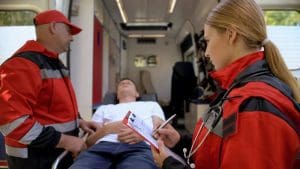Patient safety requires complete communication.
Takeaways:
- To protect patients, referring organizations, and transport professionals, a patient care report suitable to the scope of practice of the transport professional is required.
- Little information on patient reports between transport teams and transferring and receiving organizations exists.
- Understanding the various levels of transport providers and the reports needed to ensure safe patient care between facilities will help nurses and transport teams communicate clearly.
In September 2017, The Joint Commission released a Sentinel Event Alert about the importance of adequate patient handoff reports at each change in patient care. Nursing has done a remarkable job of addressing the necessary improvements among traditional nursing roles, but my experience, combined with discussions with other transport and emergency medical services (EMS) professionals, indicate a continuing knowledge deficit in handoffs to transport teams. Transport professionals report inadequate patient reports from all areas of bedside nursing practice—from outpatient clinics and offices to nursing homes, freestanding emergency departments, and inpatient hospital units. A literature search on this topic revealed no information.
Promote effective nurse-physician communication
Standardizing handoff communication
How reliable is your bedside shift report?
This article is an effort to begin remedying this lack of knowledge. Understanding the various levels of transport providers and the reports needed to ensure safe patient care between facilities will help nurses and transport teams communicate clearly.
Patient transportation
Medically trained transport teams safely and effectively move patients from one facility to another. Moves may be based on patient preference or insurance requirements, but most frequently patients are moved because the current facility lacks the tools or expertise necessary for the best patient care.
The referring facility is responsible for the patient’s condition until he or she arrives at the receiving facility, but national regulations require that interfacility patient transports operate under the license of the transport agency’s medical director. In many states, the medical director is a specially credentialled physician trained in directing pre- and inter-hospital care of patients, which is provided at four primary levels: basic life support (BLS), advanced life support (ALS), critical care, and specialty care.
Basic life support transport
BLS transports are accompanied by an emergency medical technician-basic (EMT-B). The National Highway Administration’s Guide for Interfacility Transfer defines BLS transport patients as “stable with no chance of deterioration.” Only routine vital signs monitoring is required in transit. EMT-Bs can’t perform cardiac monitoring or administer most medications, and most states don’t permit them to continue I.V. infusions, although they’re generally permitted to transport patients with saline-locked I.V. access. Many jurisdictions preclude EMT-Bs from transporting patients with patient-controlled analgesia (PCA) pumps because they’re typically a form of I.V. therapy; however, patients with implanted stimulators or long-term implanted pumps are generally permitted. Patients in need of analgesia or other medications should be premedicated before transport and that information shared with the EMT-B.
Reports at this level can omit all but significantly abnormal laboratory values due to the EMT-B’s lack of ability to correct them, with the exception of trends in glucose.
Advanced life support transport
ALS transports are accompanied by either a paramedic or an advanced EMT (A-EMT). Patients transported with paramedics are considered either “stable with a high risk of  deterioration” or “stable with a medium risk of deterioration”; those transported with an A-EMT usually are considered “stable with low risk of deterioration.” Paramedics can generally transport a wider range of medications and perform more definitive treatments. For example, an A-EMT can initiate advanced airways that don’t enter the trachea, initiate and administer nonmedicated crystalloid infusions, administer I.V. dextrose, and perform tracheobronchial suctioning of previously intubated patients. Paramedics, on the other hand, can provide those interventions and also initiate and maintain endotracheal tubes, perform emergent cricothyrotomies, perform gastric decompression, and maintain I.V. medication infusions as approved by their state, regional EMS council, and medical director. Nurses should be familiar with local EMS scopes of practice because some states (such as Pennsylvania) severely limit paramedics’ medications and treatment modalities, while other states (such as Texas) are more liberal.
deterioration” or “stable with a medium risk of deterioration”; those transported with an A-EMT usually are considered “stable with low risk of deterioration.” Paramedics can generally transport a wider range of medications and perform more definitive treatments. For example, an A-EMT can initiate advanced airways that don’t enter the trachea, initiate and administer nonmedicated crystalloid infusions, administer I.V. dextrose, and perform tracheobronchial suctioning of previously intubated patients. Paramedics, on the other hand, can provide those interventions and also initiate and maintain endotracheal tubes, perform emergent cricothyrotomies, perform gastric decompression, and maintain I.V. medication infusions as approved by their state, regional EMS council, and medical director. Nurses should be familiar with local EMS scopes of practice because some states (such as Pennsylvania) severely limit paramedics’ medications and treatment modalities, while other states (such as Texas) are more liberal.
The handoff report to paramedics should include a full nursing report but can omit items such as last bowel movement and ambulatory status, unless they’re relevant to the transport. The handoff report for A-EMTs can omit most abnormal laboratory values, except those that are critically abnormal or pertinent to the patient’s condition. Although the paramedic or A-EMT has limited ability to correct those abnormal laboratory values while en route, special note should be made so that if the patient’s condition changes during transport, the team’s medical director can make decisions based on those values.
Critical care transport
Patients being moved via a critical care transport are considered “unstable,” “stable with a high risk of deterioration,” or “stable with a medium risk of deterioration.” The critical care transport team should include at least one nurse and another provider, usually a paramedic but also could be another nurse, a physician, a nurse practitioner, a physician assistant, or a respiratory therapist. These transport teams typically provide nearly the same level of care as the unit to which the patient is being moved.
Handoff report to this transport team should be a full nursing report; however, unless directly pertinent to patient condition and care during transport, items such as last bowel movement and ambulatory status can be omitted.
Specialty care transport
Many hospital systems are implementing specialty care transport teams for patients who require skills related to treatments such as extracorporeal membrane oxygenation. The composition of these teams is determined by specific healthcare organizations. Nursing reports are the same as for critical care transport teams, with the addition of information specific to the specialty.
Handoff reports
Patient transport between healthcare organizations carries a significant amount of risk—risk to the patient and liability risk to the referring facility and transport agency. Providers must weigh the known risks of transporting a patient and compare them to the perceived benefits; nurses can help mitigate many risks during the handoff report. The referring facility retains legal responsibility for a patient from the time of the initial admission until he or she arrives through the receiving facility’s door, but the transport team also has significant legal liability. Because the team can medically intervene if the patient decompensates during the move, it must be fully informed about the patient’s condition before the transport occurs. (See Make the handoff.)
Transport teams understand that written handoffs won’t always be available; however, some forms (for example, medical necessity and demographic forms) are required for patient transport. Verbal report at a minimum (preferably accompanied by printed or electronic written documentation) should include:
- name
- gender
- age
- code status
- chief complaint
- diagnosis
- pertinent medical history
- current illness/injury history
- pertinent laboratory and imaging results and significant laboratory trends
- allergies
- medications and interventions administered within the last 24 hours and patient response
- treatment plan
- reason for transfer
- likelihood of significant negative or positive change in patient condition.
In some cases (such as a rotor wing transport that’s susceptible to weather changes and may require a quick handoff), an abbreviated verbal report (patient identification, current illness history, interventions) may be required. In these situations, the complete medical record must be available to the transport team.
Several styles of verbal report are acceptable, but it should always follow the ISBAR format (Identification, Situation, Background, Assessment, and Recommendations). In addition to the verbal report, written records also must be provided at each stage of the patient transfer process.
At least two copies of the report should be provided—one for the receiving facility and one for transport team use. The reports should be hard copies unless the transport team and the receiving facility have access to the same documentation platforms as the referring facility. In the event that the patient’s condition changes en route, the team will need its own copy so it can provide informed care and document interventions. Because the team may not be able to contact a provider to determine interventions, the report can help guide care.
The transport team also is required to provide both written and verbal reports to the receiving facility. That report may include changes in the patient’s condition or unforeseen medical events (myocardial infarction, stroke, shock) and interventions. The receiving nursing staff should never dismiss the transport team report; it may contain information that makes the referring facility report obsolete.
Transport guidelines
No nationally designated scopes of practice for EMS providers exist for interfacility transports. The governing body publications are guidelines only because of state, local, and agency training and capabilities rules. For this reason, nursing staff must be familiar with both state and local requirements for interfacility transfers. Unit leaders should contact the agencies most frequently used by their organization to discuss their information needs and patient care capabilities.
Keeping patients safe
The care modalities available to EMS providers may vary by certification level, state and local licensure requirements, and agency permissions, but they still require a patient handoff report suitable for the level of care offered during transport. To prevent errors, and so that EMS providers can maximize the patient’s condition while between facilities, nurses at the referring facility should be familiar with the EMS levels of care and tailor their handoff reports accordingly. In addition, receiving staff must pay close attention to the EMS transport team report to ensure sure any changes in patient condition are noted to prevent errors at the receiving facility. Ensuring that appropriate patient handoff reports are provided decreases liability to healthcare organizations and staff and, more important, keeps patients safe.
Chris Benson is a transport nurse at Port Area Ambulance Service in Port Allegany, Pennsylvania.
Selected references
Erdem E. Prevalence of chronic conditions among Medicare Part A beneficiaries in 2008 and 2010: Are Medicare beneficiaries getting sicker? Prev Chronic Dis. 2014;11:130118.
Joint Commission, The. Inadequate hand-off communication. Sentinel Event Alert 58. September 12, 2017. jointcommission.org/sentinel_event_alert_58_inadequate_handoff_communications
National Highway Traffic Safety Administration. Guide for Interfacility Patient Transfer. April 2006. ems.gov/pdf/advancing-ems-systems/Provider-Resources/Interfacility_Transfers.pdf
National Highway Traffic Safety Administration. National EMS Scope of Practice Model. February 2007. ems.gov/pdf/education/EMS-Education-for-the-Future-A-Systems-Approach/National_EMS_Scope_Practice_Model.pdf
Penn Medicine Physician Blog [internet]. Penn Medicine mobile ECMO: A plan in motion for at risk cardiac and respiratory patients. September 6, 2018. pennmedicine.org/updates/blogs/penn-physician-blog/2018/september/penn-medicine-mobile-ecmo-a-plan-for-at-risk-cardiac-and-respiratory-patients
Pennsylvania Department of Health. Approved and Required Medications Lists for Emergency Medical Service Agencies and Emergency Medical Service Provider. The Pennsylvania Bulletin. June 10, 2017. pehsc.org/wp-content/uploads/2014/05/Approved-Medication-List_061017.pdf
Pennsylvania Department of Health. Pennsylvania Statewide Advanced Life Support Protocols. 2018. pehsc.org/wp-content/uploads/2014/05/FINAL-2018-ALS-PROTOCOL_031618.pdf
Sethi D, Subramanian S. When place and time matter: How to conduct safe inter-hospital transfer of patients. Saudi J Anaesth. 2014;8(1):104-13.
Texas Health and Human Services. Texas administrative code: Rule §157.11:
Requirements for an EMS provider license. texreg.sos.state.tx.us/public/readtac$ext.TacPage?sl=R&app=9&p_dir=&p_rloc=&p_tloc=&p_ploc=&pg=1&p_tac=&ti=25&pt=1&ch=157&rl=11


















